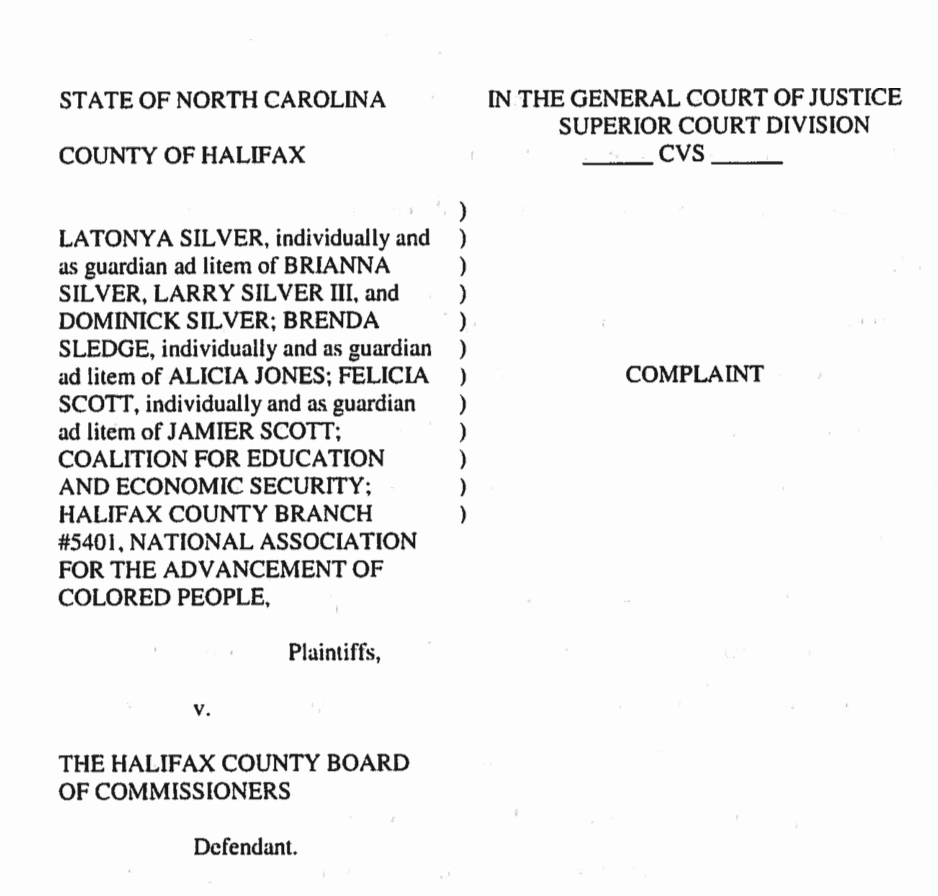

A lawsuit filed Monday by local community groups and parents in Halifax County against the Halifax County Commissioners asserted that the continued presence of three separate school districts in Halifax violated students’ right to the opportunity for a sound basic education.
As we noted in an article on Tuesday, both the chair of the State Board of Education and the Halifax Board of Education said that merger was a good idea. The superintendent of Halifax Public Schools, Elease Frederick, also said in an interview that a merger would be good for the students of Halifax.
“It sounds promising for Halifax County,” she said. “I’m very impressed.”
But leaders in the other two Halifax school districts — Roanoke Rapids Graded School District and Weldon City Schools — don’t necessarily agree.
Jay Carlisle, chair of the Roanoke Rapids Graded School District Board of Education said in an e-mail: “We the Roanoke Rapids Graded School District have no comments on the lawsuit that was filed.”
However, he also had forwarded a 2011 position paper on the topic of merging the three districts.
The paper is titled: “Joint Statement of the Weldon City Board of Education and the Roanoke Rapids Graded School District Board of Education in Opposition to School District Consolidation Proposal.”
The paper was written in response to a 2011 report from the University of North Carolina Center for Civil Rights that questioned the existence of three separate school districts in Halifax County and recommended merger.
The paper goes on at length to challenge the idea that a merger is constitutionally required, and asserts negative consequences that could arise as a result of merger, including increased taxes for Halifax residents, and a reduction in state funding for students in a merged school district. The paper also says that merger would not necessarily promote cost savings and increased efficiency.
The report states and explains that “Consolidation and Reassignment on the Basis of Race or Socioeconomic Status Could Have a Demoralizing Effect on Poor and Minority Children,” and “Consolidation and Reassignment on the Basis of Race or Socioeconomic Status Could Distract Attention from Educational Programming Initiatives.”
During a press conference Tuesday, members of the groups that filed the lawsuit discussed what they considered the continuing segregation in Halifax schools, noting that two of the school districts are majority African-American and one majority white.
The position paper talks at length about the racial make-up of the school districts and the legacy of desegregation.
“Neither RRGSD nor WCS has ever been under a desegregation order. Both districts moved quickly to voluntarily desegregate in the 1960s and cooperated fully with federal government officials. Both districts’ desegregation plans were promptly approved and implemented. As a result, both districts have been unitary for over forty years, and neither has maintained segregated facilities or denied a single student access to the public schools on the basis of race during that time.”
The paper also gives the authors’ explanation of how the three separate school districts came into existence.
According to the paper, Weldon was created by the General Assembly in 1903 and Roanoke Rapids Graded School District was created in separate legislation in 1907.
“The simpler, and more accurate, explanation for why WCS and RRGSD were created is that public schools were badly needed in those communities. Thus, the first students to attend WCS and RRGSD were not White or Black students pulled from HCS schools to enroll in new, racially homogenous, school districts; they were students of all races who happened to live in the communities of Roanoke Rapids and Weldon City and needed public schools to attend. The turn-of-the-century efforts of the citizens of WCS and RRGSD to create public schools for their respective communities reflect initiative and an understanding of the importance of education. They do not reflect a desire to create separate “white” and “colored” school districts,” the paper states.
The paper lists three ways that city and county school districts can be merged under state law.
- At the agreement of the boards of education
- A board could dissolve itself, thus forcing the State Board to adopt a merger plan.
- At the recommendation of the County Board of Commissioners, with the approval of the State Board of Education.


